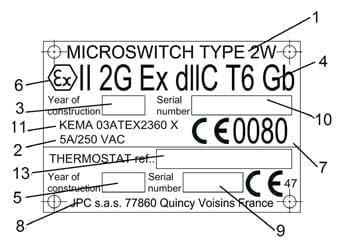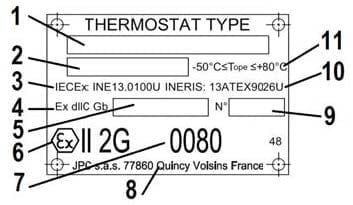Technical foreword to explosion proof products and marking
1. Protections systems against explosions used in products described in this catalogue
Electromechanical thermostats have an important characteristic that makes critical their use in potentially explosive atmospheres: the opening and closing of their electrical contact, which occurs regularly during their normal operation, produces a spark between the contacts. If they are not intended and designed specifically for being used in hazardous areas, their use becomes particularly dangerous because this spark is sufficient to ignite the surrounding atmosphere.
Historically, the solution was to use standard thermostats, and enclose them in a cast iron enclosure, with large sealing surfaces and a minimum gap between cover and frame, (described as “d” style enclosures in EN 60079-1, formerly EN50018), so that if an explosion occurred around the electrical contact, it could not extend outside the enclosure. This resulted in heavy, massive and bulky devices because this enclosure had itself to withstand the explosive ignition of the gas mixture which filled it.
Although this solution is still used by some manufacturers, JPC has developed over the past 10 years a concept for light and compact products, limiting the flameproof area to the immediate environment of the switch.
This solution allows for devices with a direct output cable (or wires), avoiding the electrical connection inside the enclosure. Thermostats, whose sizes are similar to conventional thermostats can be incorporated, according to the customer’s choice, in their own mechanical protection enclosure and electrical connection is carried away in a junction box that meets the applicable requirements of environment and hazardous areas standards. This is the reason why you will find different types of thermostats for explosive atmospheres in this catalog:
– Thermostats with wires electrical connection: (They are those having the smallest footprint) to allow installation and connection in a increased safety (Ex ‘e’ ) enclosure, but because of their components approval, it is required to apply for an additional approval of the customer enclosure with all its equipment. This solution, although these models of thermostats are the most economical, is therefore valid for large quantities applications only.
– Thermostats with cable electrical connection: In these devices, the thermostat and cable are considered as a product, and meet the hazardous area requirements if their installation instructions are fulfilled. In particular, they can be used without additional protective enclosure, by, for example, mounting them directly on a panel. It is not necessary to request an additional certificate. This solution also allows mounting the thermostat in a mechanical and ingress protection enclosure, which is not certified as equipment for explosive atmospheres. However, the cable must be mechanically protected, and the connection at its end must be made in a increased safety (Ex ‘e’) approved junction box or outside the hazardous area.
– Thermostats with cable electrical connection, inside IP54 or IP65 ingress protection metal enclosures: these enclosures are lighter, less bulky and less expensive than flameproof enclosures Ex type “b” or type Ex ” e ” increased safety enclosures. As the electrical connection is not made in these boxes, they also enable to open their boxes for set point adjustment. However, the cable must be mechanically protected, and the connection to the end must be made in an increased safety (Ex ‘e’) junction box, or outside the hazardous area. These enclosures must necessarily be earthed, and their eventual painting, if it is not antistatic, must comply with the CENELEC R044 -001 § 4.4.4 report that specifies a thickness of less than 200 microns to avoid electrostatic charges.
– Thermostats with cable electrical connection, inside IP54 or IP65 ingress protection plastic enclosures: They have the same general characteristics as metal enclosures, but offer better corrosion resistance, and are available with transparent windows. For the same reasons than metal enclosures, they must comply with§ 7.3 of the EN60079-0 standard, which specifies a certain electrical conductivity to avoid the building of electrostatic charges. Some enclosures whose windows, made of non-antistatic plastic, have surface areas between 2500 and 10000mm², can be used , even if the internal thermostat has an approval for gases IIC.
–Thermostats incorporated inside increased safety metal enclosures, (Ex approval “d” + “e “)
The explosion-proof thermostat is installed and connected in an increased safety enclosure, specially designed for thermostat. This solution allows electrical connection inside the housing, but does not allow thermostat set point adjustment by opening the enclosure when energized. The cable exits and the capillary cable gland must be Ex-“e” certified cable glands (which can be selected and installed by the customer), and the terminals are also Ex-“e” certified, and cannot be modified or replaced by other models without cancelling the approval.
2. Thermostat identification plate printings
|
Thermostats type KW with ingress protection enclosure |
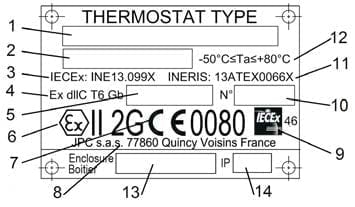
Thermostats types KA, KB, KC, KD, KE, KF, KG, KH, 4A, cable electrical connection, with or without ingress protection enclosure |
Thermostats types KA, KB, KC, KD, KE, KF, KG, KH, wire electrical connection. Types with protection enclosure must have an additional certificate. |
| 1: Type of micro-switch used in the thermostat 2: Electrical rating. 3: Microswitch manufacturing year 4: Gas use code (see detail herunder) 5: Thermostat manufacturing year. 6: Atex logo and code (see detail herunder). 7: Atex code of certified body that has CE approved the quality organization of the manufacturer (code 0080= Ineris). 8: Manufacturer name and address. 9: Thermostat serial number 10: Switch Serial number. 11: Atex approval number 13: Thermostat reference number |
1: Thermostat reference, 13 characters. (characters 3, 4, 5, 6, 7, 8 give the temperature range in °C) 2: Electrical features and electrical rating. 3: IECEx approval number 4: Gas use code. see detail herunder). 5: Manufacturing date. 6: Atex logo and code (see detail herunder). 7: Atex code of certified body that has CE approved the quality organization of the manufacturer (code 0080= Ineris). 8: Manufacturer name and address. 9: IECEx Logo (option not used on most thermostat models) 10: Serial number. 11: Atex approval number 12: Thermostat housing min. and max. ambient temperature (variable value depending on thermostat models). 13: Extra ingress protection enclosure, IP54 or IP65, when the thermostat is used inside an extra enclosure. A second nameplate is also riveted outside the extra ingress protection enclosure. When delivered without extra enclosure, it is stamped XXXX 14: Ingress protection class of extra enclosure. When delivered without extra enclosure, it is stamped XX |
1: Thermostat reference, 13 characters. (characters 3, 4, 5, 6, 7, 8 give the temperature range in °C) 2: Electrical features and electrical rating. 3: IECEx approval number 4: Gas use code (see detail herunder). 5: Manufacturing date. 6: Atex logo and code (see detail herunder). 7: Atex code of certified body that has approved the quality organization of the manufacturer (code 0080= Ineris). 8: Manufacturer name and address. 9: Serial number. 10: Atex approval number 11: Thermostat housing min. and max. ambient temperature |
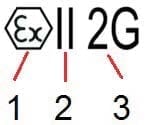 |
 |
| This inscription defines the hazardous zone and the occurrence of explosive gaseous atmospheres (gases, vapors or mists) This classification of equipment in distinct areas is made according to ATEX 1999/92/EC1: Logo of conformity to ATEX European standard.2: Group II, Equipment intented for use in places with an explosive gas atmosphere other than mines susceptible to firedamp. 3: 2G. Intermittent presence of explosive atmosphere in normal operation (likely) |
1: Ex. specific symbol devices for protection against explosion according to EN and IEC standards. 2: d. Electrical apparatus for use in gaseous atmospheres with explosion proof enclosure protection according to EN 60079-1 3: II. Electrical equipment intended for use in locations, other than mines, where a potential explosive atmosphere exists ( surface industries ) 4: C. Type of explosive gaz. Grade C covers the most explosive gas such as acetylene , carbon disulfide and hydrogen. An approved device grade C is used for all gases as defined in the lower grades 5: T6. Temperature surface reached by the thermostat housing in operation, due to its internal self-heating in most adverse conditions . T6 is the the lowest class of self-heating, and corresponds to a maximum surface temperature of 85°C. In some products, this surface temperature class can be T5. Note: this surface temperature T* does not exist on the component certificates 6: Gb. Corresponds to the ” EPL ” (equipment protection level) specification. Gb level corresponds to the possibility of using products in risk areas 1 and 2 (presence of intermittent explosive gas in normal use, and occasional presence of explosive gas in an abnormal situation ), corresponding to the 2G classification of the European Directive 94/9 (ATEX) Equipment for explosive gas atmospheres, having a “high” level of protection, which is not a source of ignition in normal operation or when subject to faults that may be expected, though not necessarily on a regular basis. |
| Inscriptions on “e”increased safety enclosures with one or two built-in “d” explosion proof thermostats | Inscriptions on increased “e”safety junction boxes |

|
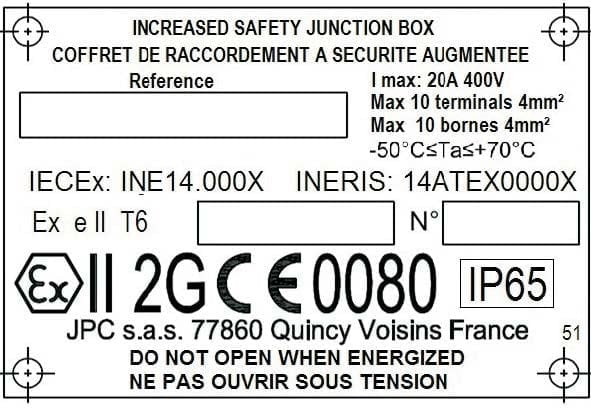
|
| 1: Thermostat reference, 13 characters. 2: Electrical features and electrical rating. 3: IECEx approval number 4: Gas use code.(d+e marking means that it is an increased safety enclosure including an explosion-proof device)). 5: Manufacturing date. 6: Atex logo and code (see detail here-over). 7: Atex code of certified body that has CE approved the quality organization of the manufacturer (code 0080= Ineris). 8: Manufacturer name and address. 9: Ingress protection class IP 10: Serial number. 11: Atex approval number 12: Thermostat housing min. and max. ambient temperature (variable value depending on thermostat models). 13: Safety warning |
1: Thermostat reference, 13 characters. 2: Electrical features and electrical rating. 3: IECEx approval number 4: Gas use code.(d+e marking means that it is an increased safety enclosure including an explosion-proof device)). 5: Manufacturing date. 6: Atex logo and code (see detail here-over). 7: Atex code of certified body that has CE approved the quality organization of the manufacturer (code 0080= Ineris). 8: Manufacturer name and address. 9: Ingress protection class IP 10: Serial number. 11: Atex approval number 12: Thermostat housing min. and max. ambient temperature (variable value depending on thermostat models). 13: Safety warning |

